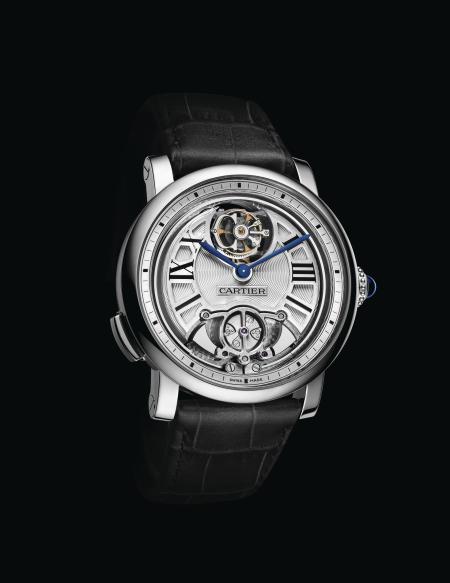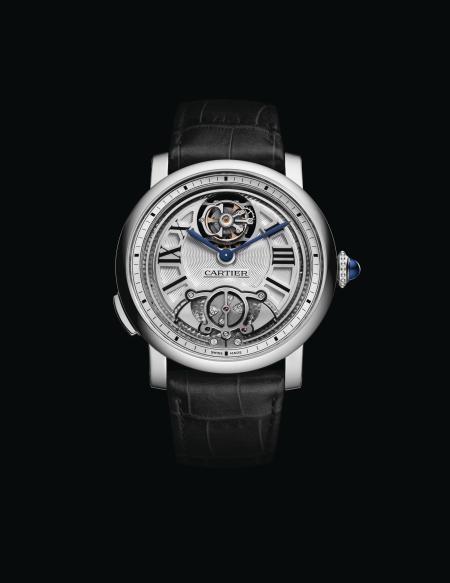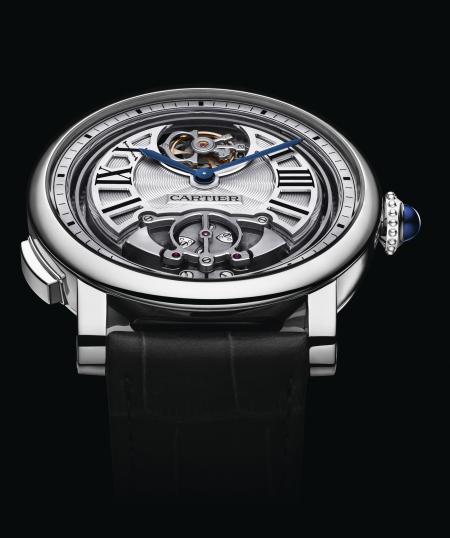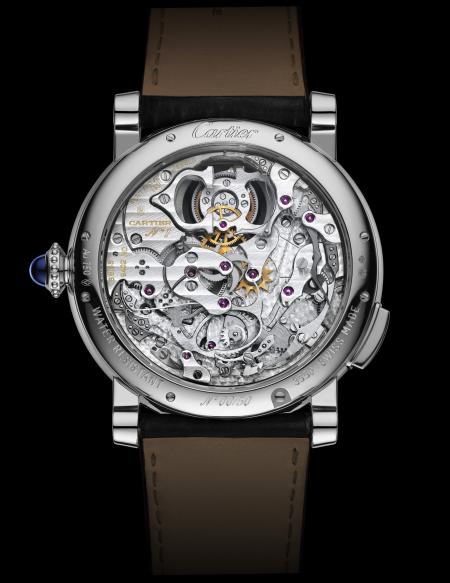Novelty SIHH 2012 – Cartier
By MyWatch
Of all the complication models in existence, minute repeater watches are collectors’ favourites since they give purely mechanical processes a more poetic dimension and offer the opportunity to follow the passage of time through music. More subtly, the Rotonde de Cartier Minute Repeater Flying Tourbillon watch reminds us that announcing the time of day by means of sound has always been, in all civilisations, one of the exclusive prerogatives of the centres of power and authority. This ability to announce the time in a different way certainly gives this complication pride of place in the subtle hierarchy of watchmaking features.
A fresh approach to the theory of sound propagation
The Rotonde de Cartier Minute Repeater watch is the fruit of five years of research into watch acoustics. It was long thought that the knowledge acquired over the centuries was sufficient. However, the rigorous quality standards and the very conception of today’s watches together with modern methods of scientific analysis have brought to light a significant number of defects in the way that time measurement is converted into sound.
Cartier’s Research and Development Department has thus taken up the challenge of offering lovers of fine watchmaking a minute repeater watch which, while remaining traditional in its design, represents a synthesis of in-depth acoustic research as applied to watchmaking.
The Cartier watch movement development team has set itself the task of redefining the underlying scientific factors on which the acoustic appreciation of a minute repeater watch is based. As a starting point, it was necessary to redefine the very concept of sound itself, which can be considered as the auditive sensation engendered by an acoustic wave. This wave, which may be compared to the ripples produced by a stone that falls into water, displaces particles in the medium of propagation. These constitute air vibrations that the middle ear transforms into vibrations that can be analysed by the inner ear.
What the ear hears…
An organ of rare complexity, the ear, although extremely fragile in appearance, is capable of assimilating a large amount of information to identify a sound and measure its force. Any given sound is the sum of a volume defined in decibels (a unit of acoustic intensity as represented by the level of sound pressure exercised on the ear), of a pitch (high or low), of a frequency (the number of vibrations engendered by the body of sound per second), and of a duration (time period).
Each of these values that form the sound must be considered individually during the creation of a minute repeater watch, and must ultimately lead to the transmission of a sound that is clear, powerful, regular and crystalline, without any trace of echo or parasitical induction that could spoil the pitch of the notes intended to give a fine sound dimension to time measurement.
… the eye sees
As one of the defining concepts for the Rotonde de Cartier Minute Repeater Flying Tourbillon watch, the Manufacture Cartier has paid particular attention to the presentation of the external parts of this state-of-the-art watch with a classic personality. Numerous acoustic tests have been conducted so as to validate a certain number of theories concerning the cases of watches with striking mechanisms.
Foremost among these are the tests carried out by Cartier’s team of engineers and watchmakers involving modules made of different materials and enclosing the same music-box. These have made it possible to develop a new watchmaking theory in relation to the transmission of sound, based on a relationship between volume (45 mm), weight (approx. 32 grammes) and power (68 decibels).
The equation may best be summarised as follows: the lower the weight of a repeating watch’s case and the larger its diameter, the greater its capacity to produce a loud sound. Which is why Cartier has chosen to present the Rotonde de Cartier Minute Repeater watch in grade 5 polished titanium with a 45 mm diameter.
For it is all a question of vibrations
To ensure the harmonious transmission of an acoustic wave, there needs to be a very strong link between the part emitting the sound wave and the parts intended to receive it. Today Cartier proposes a new watchmaking concept that consists of linking the gong to the plate and linking the plate to the middle of the case at four points. To optimise this link, the heels of the two gongs of the minute repeater are finally screwed down, each at a particular point inside the case. The perfect synergy between the case and the movement thus aids the transmission of the vibrations.
Since square gongs allow the hammer to strike regularly at the same place despite the fact that the blade of the gong has started to vibrate, the acoustic waves are thus harmoniously diffused throughout a wide emitting surface. It is however essential that these harmonious sounds transmitted through the air be struck in a regular way so that they can be both appropriately interpreted and specifically counted by the brain. To produce the constant striking of the hammers, the Rotonde de Cartier Minute Repeater Flying Tourbillon watch is equipped with a mechanism known as an “inertia and friction governor”, which is particularly silent and sophisticated.
Thanks to an aperture in the open-work dial, this objectively very efficient organ is visible with its slate-coloured galvanised silver-plating in the extension of the flying tourbillon escapement positioned at 12 o’clock. It enters into rotation so as to control the speed of the winding of the minute repeater’s strike-train and at the same time ensure the regular emission of the notes sent out by the watch’s two gongs.
In this way the ear is enchanted by the tune marking the hour while at the same time the eye is captivated by the frantic whirling of these two extremely complex mechanisms. In this dual action, one mechanism has the illustrious task of regulating the passage of time at a rate of one revolution per minute and 21,600 vibrations per hour for the balance. The other dedicates itself to moderating the rhythm of the music by controlling the winding of the spring contained in the barrel of the minute repeater mechanism manually reloaded by means of a push-piece incorporated into the case middle at 8 o’clock. The choice of a push-piece to replace the traditional bolt that is habitually observed on the side of minute repeater watch cases, answers the need to reduce the case mass / gong mass ratio that determines the power of the vibrations. Being smaller and, in particular, being concentrated at one specific point on the case, the push-piece thus enables the mass of the case to be significantly reduced.
Marking time with sound
Connoisseurs of fine mechanical devices will be sure to turn back the time again and again once they have activated the push-piece positioned at 8 o’clock so as to enjoy the whirling dance of the strike-trains, racks, star-wheels and snails found in the fascinating minute repeater mechanism. This watch, with its 45 mm diameter and available in titanium or in pink gold, has a 9402 MC movement, 447 parts and 47 jewels, and bears the Geneva Seal – the mark of its impeccable quality of craftsmanship. It will be appreciated for its incredibly light weight, achieved through the extremely delicate nature of its mechanical parts, and will be proud to demonstrate the clarity and power of its strikes to whoever cares to listen.
An exceptional model combining two of watchmaking’s traditional grand complications, the Rotonde de Cartier Minute Repeater Flying Tourbillon watch is the first representative of a new generation of high-level timepieces. Proposed in a numbered limited edition of 50 models in titanium and 50 models in pink gold, this new Cartier creation also exists in a version set with baguette-cut diamonds.



